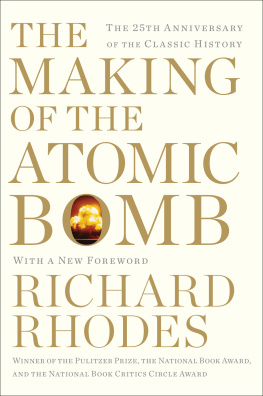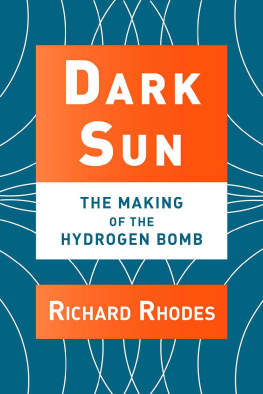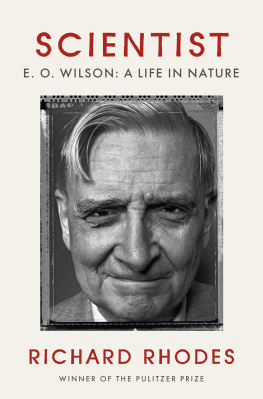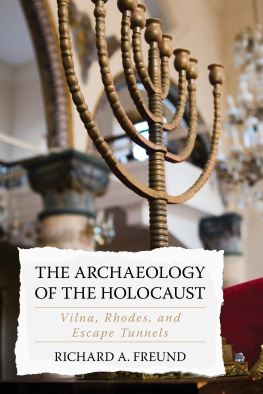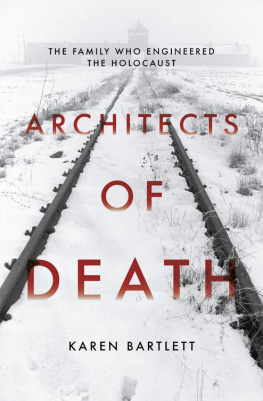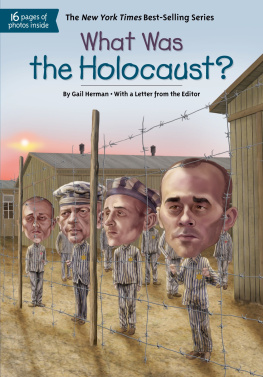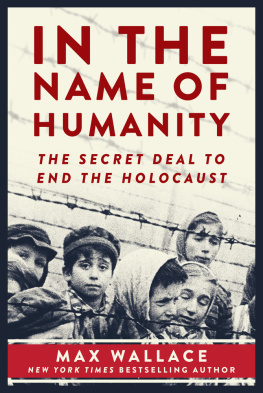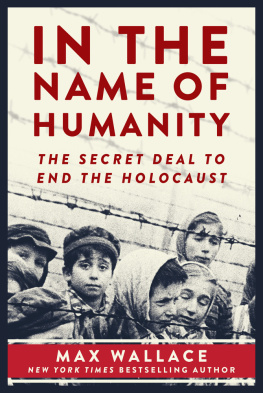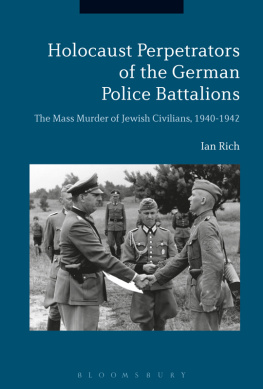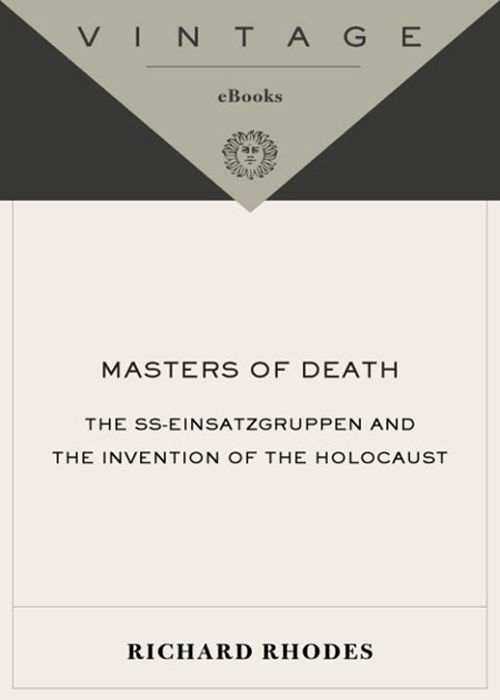

Table of Contents
For Laurie Anne Pearlman and Ervin Staub
Death is a master from Germany his eyes are blue He strikes you with leaden bullets his aim is true
PAUL CELAN, odesfuge
Acclaim for Richard Rhodess
MASTERS OF DEATH
Powerful.... Not only an important work but a morally necessary one.
Houston Chronicle
Rhodes breaks searing ground.... Without reminders like this, we might never learn.
heAtlanta Journal-Constitution
Graphically and chillingly details the work of the special killing battalions of Himmlers SS.... Extremely well-written.... [A] fine work of gruesome history.
JerusalemPost
Powerfully concise.... [Rhodes] continues his authoritative research with a story that is wrenching in human terms.
heKansas City Star
Riveting history.... Unrelenting.
heWeekly Standard
This latest contribution to the debate about the origins of Nazi behavior the processes of socialization to butchery is dreadfully timely.
Newsweek
AUTHORS NOTE
On the grounds of a commercial rose nursery in Vinnitsa, a town in western Ukraine, two long, grassy beds and a smaller, square bed beside them have been set off with white wrought-iron fences and marked with stone memorials. A Ukrainian historian, Faina Vinokurovaa warm, buxom woman with red hair and commanding presenceled me to this place of sunlight and roses on a June day not long ago. As we stepped around the wooden driveway gate onto the nursery grounds, Ms. Vinokurovas shoulders slumped and her face filled with immeasurable sadness. The long beds had been killing pits, she explained. Four thousand people, Ukrainian Jews, had been murdered there on 16 April 1942. We went over to the smaller bed. It had been a killing pit as well; it held the remains of a thousand murdered children.
Vinnitsa was the last killing site I visited to walk the ground where the events described in this book took place. I had started in Warsaw two weeks earlier, had toured what remained of the death camps at Treblinka, Majdanek and Auschwitz-Birkenau, and then had moved on to places with names less well known: in Lithuania, the Ninth Fort and Ponary; in Belarus, Katyn and Maly Trostinets; in Ukraine, unnamed sites in Uman and Zhitomir, as well as the nursery beds in Vinnitsa. One site I visited almost everyone has heard of: Babi Yar, a ravine in Kiev, where in September 1941 a killing squad led by a tall, mean, drunken former architect named Paul Blobel murdered thirty-four thousand people in two days.
But there were dozens of Babi Yars. Hundreds of killing sites mark massacres from Tallinn on the Baltic Sea in Estonia southward to Odessa on the Black Sea in Ukraine. They were the work of special task forcesin German, Einsatzgruppenorganized by SS-Reichsfhrer Heinrich Himmler and his second-in-command, Reinhard Heydrich, to follow behind the German army as it advanced into eastern Poland and the western districts of the Soviet Union beginning in late June 1941. The ostensible purpose of the Einsatzgruppen was to secure the rear areas from partisans and saboteurs. In fact, their assignment was to murder Jews, not indirectly by herding them into gas chambers but directly, by shooting them into antitank ditches, natural ravines or pits freshly dug by Russian prisoners of war.
The story of the Einsatzgruppen is almost unrelievedly grim, which is perhaps why it has hardly been told. You may well ask why you should submit yourself to the experience of reading about such events. I asked myself the same question, and asked it again more than once as I researched and wrote this book. One answer is that it is impossible to understand how the Holocaust unfolded without knowing this part of the story, because the Einsatzgruppen massacres preceded the invention of the death camps and significantly influenced their development.
Another answer is that the Einsatzgruppen story offers insights into a fundamental Holocaust question: What made it possible for men, some of them ordinary men, to kill so many people so ruthlessly? As a guide to that question, I have drawn on the research of criminologist Lonnie Athens, which I reported in my previous book Why hey Kill. Athens identifies experiences of violent socialization as the fundamental cause of violent criminality, and certainly the violence of the Einsatzgruppen, directed without provocation against unarmed victims, was criminal. I review Athenss violent-socialization model of violence development in Chapter 2 and integrate it with its institutional equivalent, which is military and police training and experience.
But the answer that made the most sense to me personally came to me when I remembered the anger that had pushed through the sadness I felt walking among the mass graves in Vinnitsa with Faina Vinokurova: that these victims herded to their deaths deserved written witness, victims who hardly had time to say farewell to the loved ones beside them as they descended into those long graves, victims whose children were torn from their arms, victims who left little record behind. The least I could do, it seemed to me, was work out a narrative of Einsatzgruppen crimes, and if reading about those crimes was painful, it did not even remotely compare to what the victims went through.
PART ONE
THE WAR IN THE EAST
ONE
Eastward from Pretzsch
In the spring of 1941 a police academy in Pretzsch, a town on the Elbe River about fifty miles southwest of Berlin, became the site of a sinister assembly. Several thousand men from the ranks of the SSthe Nazi Partys Schutzstaffel, or defense echelon, a police and security service that answered directly to Adolf Hitler and operated outside the constraints of German law were ordered to report to Pretzsch for training and assignment. They were not told what their assignment would be, but their commonalities offered a clue: many of them had served in SS detachments in Poland, which Germany had invaded and occupied in 1939, and preference was given to men who spoke Russian.
Assignment to Pretzsch emptied the SS leadership school in Berlin-Charlottenburg and depleted the professional examination course of an SS criminal division. It drew in lower- and middle-ranking officers of the Security Police (the Gestapo and the criminal police), some of them passed on gratefully by their home regiments because they were considered too wild. The Waffen-SS, the small but growing SS army, contributed enlisted men. High-ranking bureaucrats within the shadowy Reich Security Main Office, Most of these handpicked leaders were lawyers, and a few were physicians or educators; most had earned doctoral degrees. Among the more exotic specimens were Otto Ohlendorf, a handsome but argumentative young economist who had fallen into disfavor with Himmler; Paul Blobel, a rawboned, highstrung, frequently drunken architect; Arthur Nebe, a former vice squad detective and Gestapo head who had enthusiastically volunteered; and Karl Jger, a brutal fifty-three-year-old secret police commander. A reserve battalion of the regular German Order Police (uniformed urban, rural and municipal police) completed the Pretzsch roster.
Soon the men learned that they would be assigned to an Einsatzgruppe a task force. Einsatz unitsgroups and commandos had followed the German army into Austria, Czechoslovakia and Poland when Germany had invaded those countries successively in 1938 and 1939. Einsatzgruppen secured occupied territories in advance of civilian administrators. They confiscated weapons and gathered incriminating documents, tracked down and arrested people the SS considered politically unreliable and systematically murdered the occupied countrys political, educational, religious and intellectual leadership. Since Germany had concluded a nonaggression pact with the Soviet Union in August 1939, many of the candidates at Pretzsch assumed they would be assigned to follow the Wehrmacht into England. Some of them had previously trained to just that end.
Next page

